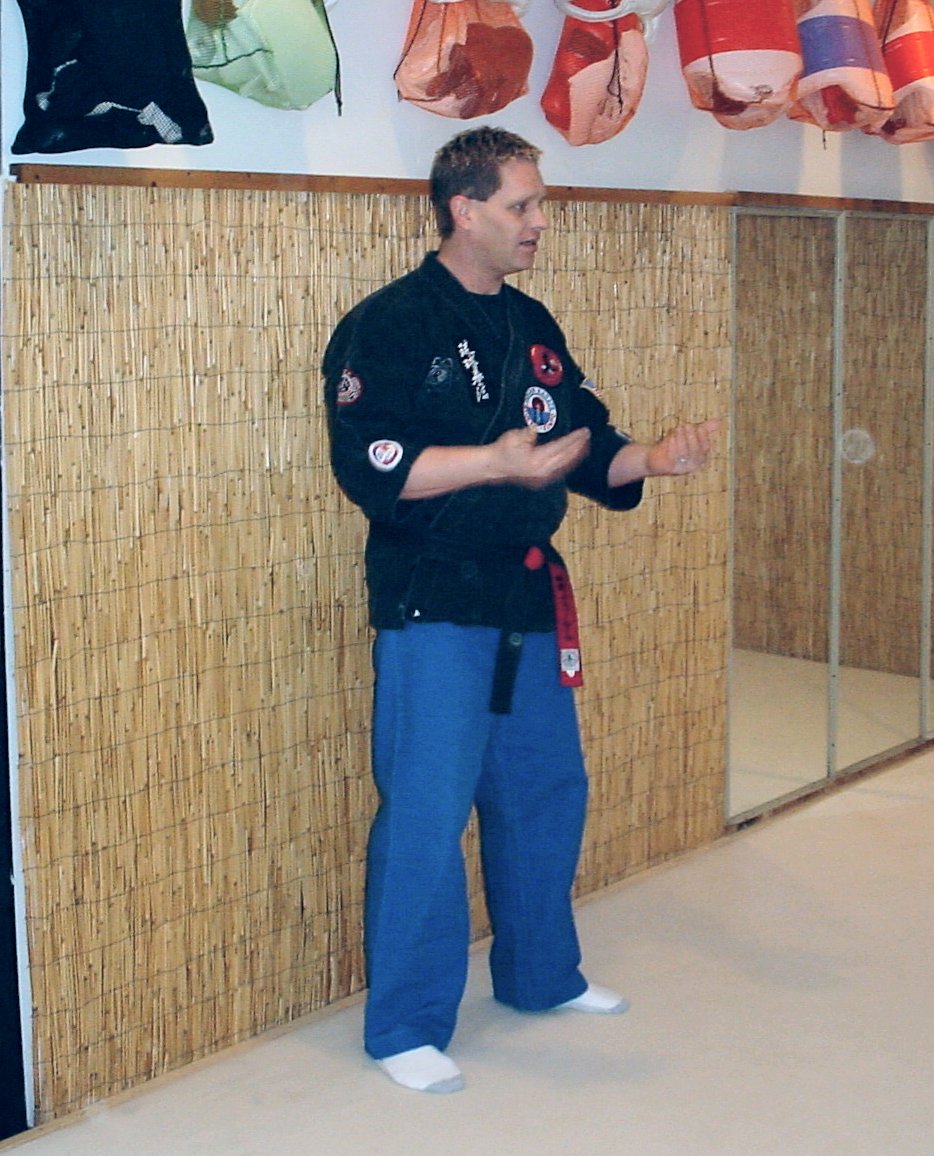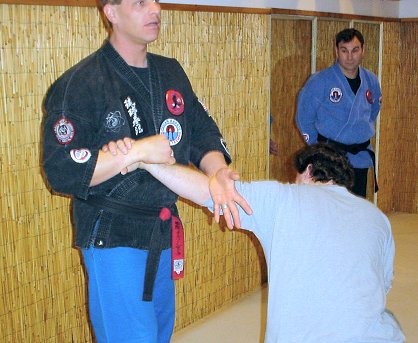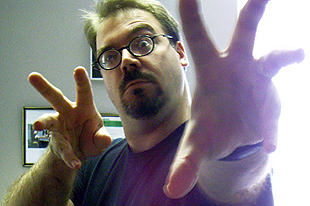its paid sponsors, whose products you need!
| Home |
| Intro |
| Current Issue |
|
Mailing List |
| Store |
| Strength |
| Subscriber Content |
| ARCHIVES
|
| Martialism |
| Pacifism |
| Q & A |
| Cunning-Hammery |
| Advertise With Us |
| Submit An Article |
| Staff |
| Discussion Forum |
| Links |
“Stay ‘unreasonable.’ If you
don’t like the solutions [available to you], come up with your
own.”
Dan Webre
The Martialist does not
constitute legal advice. It is for ENTERTAINMENT
PURPOSES ONLY.
Copyright © 2003-2004 Phil Elmore, all rights
reserved.
Presure Point Fighting
By Danny Rowell
Yeah,
I know what youre thinking. What a load, right? Like some guy is going to
come up and tap you a few times and youll fall paralyzed on the ground
twitching like a bunny rabbit. Its good that youre cynical. Dont take
everything you read and hear and see as the gospel. Its like they say in Missourah:
“Show Me.”
Those of use who are martialists at heart actively seek new information
and experiences. Its in keeping with what our beloved Publisher likes to quote from Ayn
Rand: “Keep an active mind.” Those out there who poo-poo everything are
just as bad as those who believe everything. I am neither of those types,
so I decided to check into this whole pressure point thing.
 Dave Daniel
Dave Daniel
(right), the Pacific Northwest Director of Hogan Karate
International, was gracious enough to visit the Kashimunji Dojo on the 21st of
February, 2004. We have a small dojo, so we were limited to a small group. Dave
brought with him some 33+ years of martial arts training (18 of which
are pressure point specific) as well as Dan McClusky (Daves instructor) and Pat
Crane (the Director of HKI for the State of Idaho). We were blessed with three
talented and energetic pressure point instructors.
The students of Kantan Kyo Jujutsu are no strangers to
pressure point theory. We study the healing aspects of shiatsu and massage on
a regular basis. However, the destructive applications of pressure points are
not the focus of our training. Fortunately, Mr. Daniel is well versed.
The seminar was informal. Dave began by giving us some
background on himself and the history of pressure point training in the United
States. Mr. Daniel has trained extensively in the past with
George Dillman.
He has, therefore, been in the inner circle of the pressure point enthusiasts for
many years.
After a few minutes of background, we went right into doing
some basic techniques. If youve ever been to a seminar youll understand that
most techniques are initially taught “defending from a wrist grab.” In
thirty-one years, Ive never had anyone come grab my wrists. Every
training technique has to start somewhere, though, so we worked on defending from a
single hand wrist grab.

Dave Daniel explains the pressure points of the arm on “Nabok.”
Dave explained that there are 6 key pressure points up the
forearm. There are two on either side of the wrist, two halfway up the forearm, and two
just below the elbow. I wont go into any details, as that information can be
too deadly if it falls into the wrong hands.*
We proceeded in testing the first point and affecting a
release from the wrist grab by attacking the first point. That made it
very difficult for the attacker to hold on. It wasnt that the point caused
extreme pain; the grip simply lost a lot of its strength. Dave explained that
what we were doing was disrupting the flow of “chi.” For those of you who dont
believe in chi, think of it as disrupting the electrochemical signals between
the brain and the gripping hand. There is a simple example of this that we
will discuss later in the article.
*Obviously sarcasm Editor.
trades), especially when it comes to martial arts and self-defense. Recently,
I added some new tools to my bag of tricks. Danny Rowell, Kashimunjis
resident seminar promoter, arranged for Dave Daniel to give us a brief
introduction to the interesting and painful application of pressure points.
Over the years I have picked up a little bit about pressure points in
different schools, books, and informal training sessions. After I worked a
few hours with Dave and his team, I learned more than in all the years of
trying to piece things together myself.
Pressure point theory is a deep and complex subject. However, Dave and his
crew were able to clearly and concisely explain it to a group of students
whose previous experience with the subject ranged from intermediate to total
novice. Dave also did an excellent job of transferring what is commonly
thought of as a predominately striking style to our more grappling friendly
approach.
Okay, okay, does it work? Well I can’t knock Danny “Spanky” Rowell out from 30 feet away,
at least not yet. A week after the seminar our class was working on some
simple defenses from grabs with some junior students. As often happens, Spanky and I ended up working together doing some counters, reversals, and
variations on the basic topic. Then I threw in one of my shiny new pressure
point tricks. Judging from Spankys reaction and his desire to try it out on
me, they work and work well.
I am not ready to stand toe-to-toe slugging it out with someone trying to
hit a series of points with the correct force and direction, but pressure
points do have a place in my practice. With proper training and work they
may well find a place in yours. If you have a chance to work with Dave
Daniel you wont be sorry, despite what the photos of Dave lighting me up
would have you think.
Needless to say, it was difficult for the attacker to hang
onto the wrist once the pressure point was “activated.” For the next hour or
so we proceeded to train techniques that utilized each of the 6 points that
had been discussed in the beginning. During the second hour, we worked on some
of the pressure points on the top of the foot and up the sides of the shin and
thigh. Each technique affected the attacker a little differently and
facilitated the escape of the trainee. I wont get into how and when and why,
because in truth I dont understand it well enough to explain it.
I do know that when my training partner hit a pressure point,
I felt it. Sometimes it was only a light tingle or pressure. Sometimes the
point caused intense discomfort. Anyone still dismissing the reality of
pressure points must be someone whos never shellacked their funny bone or had
the doctor bounce his or her knee with that little hammer.
For myself, Ive never doubted that pressure points exist
or that they can be triggered to have certain effects on the human body. My
doubts have always come from using them in combative situations. Mr. Daniel
provided many anecdotes describing how hes used them in situations as a bouncer and in
other circumstances. Those stories are fun and, just like all stories
concerning martial prowess, subjective in nature. Ive heard and read many
stories of these types of events, and I take everything with a grain of salt.
This past month we hosted a wonderful visit by three of the Treasure
Valley’s foremost experts in Tuite: Dave Daniel, Dan McClusky, and Pat
Crane. First of all, let me send a hearty “thank you” (from me and all my
students) to these gentlemen for sharing their time and expertise with us.
All three were skilled in their art and are fine instructors who can both
explain and listen. For two hours on a Saturday morning, Dave led us through
several examples of self-defense pressure point applications. Although his
context for lower arm attacks consists of Kempo
Karate strikes, the translation to Koryu Jujutsu was straightforward. For
example, “inside cross block” became “gyaku kote gaeshi.”
In other words, there were no huge surprises technically. Like most
techniques, however, the devil is in the details. Dave revealed several
little details (i.e. pressure points) that we had not exploited before.
Application of technique was straightforward and results were easily felt,
regardless of whether one was playing the role of uke or tori. I was most
impressed by Dave’s familiarity with these points their locations, names,
usage, and effects. In all my years of martial arts study and practice,
pressure points have held secondary interest. Of course, I recognize the
utility of pressure points and I have studied them within the context of
massage and Eastern healing, but I had never bothered to learn the maps.
After working with our brothers from the Hogan Karate
International family, I am now motivated to take the plunge. Not only am I
reviewing my pressure point references, but I’m also dragging my students
with me. We have begun with a review of Yin/Yang and the 5 elements. Next up
are the 12 meridians. I hope we all gain a deeper understanding of the tools
we already use. Dave’s workshop was a healthy push in the right direction. I
would recommend his seminars to all martial art enthusiasts.
I was able to spend some time in contemplation in the weeks
following our seminar. Ive been in discussion with Dave, my instructor,
and a few other martialists I know ,bouncing theories and ideas off them.
Mulling over what I have learned with what I experienced in the
seminar, Ive come to several conclusions.
First, pressure points are real. There are nerve clusters
all over the body that can be stimulated and have either a negative or a
positive effect on the human body. I have experienced shiatsu, acupressure,
acupuncture, “laying on of the hands” healing, some chiropractic, and some
Tokyo massage work in my time (ok, not really the last one). Each of these
has had an effect on me not entirely different from Mr. Daniel’s pressure point
techniques.
 A
ALittle Perspective, Take Three (From Your Editor, Phil Elmore)
I can hear the critics howling now. By including an article on
pressure points, has The Martialist bowed at the altar of Traditional
Martial Arts, embracing the unworkable?
Well, no.
In my own training at the Syracuse Wing Chun Academy, we strike nerves
and pressure points for greater effect when hitting. While my own
instructor often speaks of “chi,” there’s no need to see this as some sort of
mysticism. Your body is a biological mechanism that operates according
to certain principles and has certain vulnerabilities. Learning to hit
its most vulnerable points is not some magical process, but simple science.
It remains science no matter how you dress it up and no matter in what
metaphorical terms you describe it.
Where I will state flatly that something is bunk is any scenario in
which “no touch knockouts” or the “power of focused chi” is invoked.
This is ridiculous. No one can knock you down without touching you
unless you cooperate. I’ll challenge any of the no-touch-knockout
chi-crazies to use the power of their mystic arts on me any day, and I’ll even
buy lunch if they can knock me down. They can’t.
So, yes, pressure points are real but don’t expect unrealistic things
from them. Whatever you do, don’t use questionable techniques or methods
you think MIGHT work when you can apply more proven, less risky techniques to
resolve the situation.
Second, not all points work on all people and they are
subjective to the situation. In truth, this isnt any different than palm
heels and foot stomps. They have a higher percentage of efficacy, but as every
martialist knows, nothing works all the time. Some techniques dont work on
some people, period. The key premise, as I understand it, is that you get the
opponent’s mind and body going in two different directions. Like kazushi in
Judo, all it takes is to get your opponent off balance for a split second and
you can, if youre timing is right, bounce him on his butt. That old Arab
proverb comes to mind about the camels nose in the tent.
Third, as in all demonstrations of martial prowess, the
attacker is compliant and the defender knows how the attacker will move. That
makes demonstrations more effective and, in truth, more entertaining for the
participants. During the seminar I succumbed to the mental questioning of “oh
yeah, what if I do this” a few times. I immediately answered my own question
and could imagine Dave replying, “if you do this, then Id do something else
and round and round we go. Instead of going down that path, I told myself to
shut up and listen in order to learn something.
Now is a good time to talk about that little demonstration I
mentioned earlier. Youll need a partner, but not much else. Have your partner
hold his arm out at shoulder height to his outside. For example, have him
hold his right arm out straight so his right shoulder and right wrist are
aligned horizontally. The arm should be firmly in place. Tell him not to
let you push his arm down. You push down with moderate force on his arm.
Push out near his wrist and see how much you can move his arm. Dont get
carried away and jump up and down on his arm to get it down. Thats not the
point.
Tell him to keep his arm up. He shouldnt be relaxing between test one and
test two. After you test his arm, take your hand and move it down from the
top of his head to his belly button. Do not touch him. Act as though youre
removing a spider web that is floating right in front of your training
partner. Then try to push his arm down again. Ideally, it will take
significantly less pressure and his arm will move easier than the first try.
We experimented with this during our regular training and it is a neat
trick, but not too difficult to figure out. We even mixed it up, having the
uke close his eyes and mediate. It still worked. It did not work as well, but it still
worked. How? It has something to do with getting the uke’s mind and body going in
two different directions something we would refer to in the Infantry as a
Jedi Mindfuck.
Fourth, I did learn some things from Dave and his cohorts. I
learned and Dave explicitly hit on this point that just like everything else
you train, pressure point fighting is not the Do-All-End-All-Grand-Ultimate-Style. Pressure point fighting is simply another tool to add to your skill
set. With lots and lots (and lots) of practice you can become extremely
skilled at hitting the points on your opponent. With only a little
training, you can learn some nasty stuff to integrate into your own style.
You can use this against your training partners and, God forbid, a bad guy who wants to
steal your shoes.
The bottom line is this simple: You can pick up some
pressure point theory and see if you can work it into your training, or you can
spend your time doing other things. As we say at The Martialist, the choice is
yours. I know Ill be following up as the opportunities present themselves.
Every little bit of knowledge is helpful. Besides, as a martialist, I love to
cheat.
Win if you can. Lose if you must. But
ALWAYS cheat!
